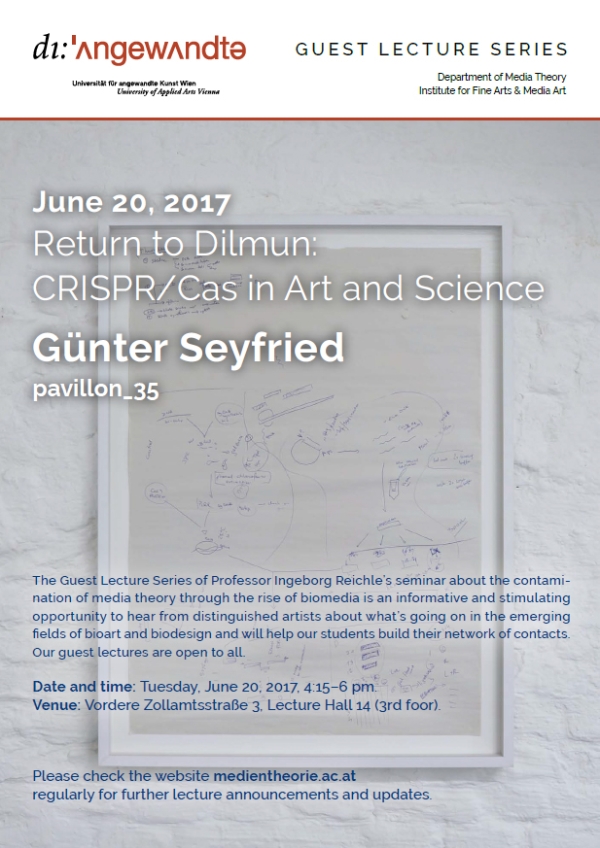The Austrian artist Günter Seyfried (pavillon_35) will give a talk about current methods of genome
editing utilised in his new art project.
In his artist talk “Return to Dilmun: CRISPR/cas in
Art and Science” he will describe his encounter with citizen (non-professional) science and genome editing, as well as the
formation of amateur, do-it-yourself biology (DIYBio) groups: The art work by Günter Seyfried and his collaborators (Roland
van Dierendonck, Hansjörg Petschko, and Frederico Muffatto) Return to Dilmun focuses on CRISPR (Clustered regularly interspaced
short palindromic repeats) / cas (CRISPR-associated system) a new genome editing technology that is able to permanently modify
genes within organisms. The technology, which was only “discovered” a couple of years ago functions as an extremely precise
“DNA scissors”, and since then labs around the world have demonstrated the potency of the method, similar to the case of PCR
(polymerase chain reaction) in the early 1980s. The CRISPR/cas system is a prokaryotic immune system, which provides adaptive
(acquired) immunity against foreign genetic elements, such as bacteriophage genome injection. Return to Dilmun centres on
the code of a digital image that has been translated into synthetic DNA using a special process: In two types of in vitro
experiments the team performed image manipulation at the level of molecules. In one experiment the team made a number of experiments
aiming at efficient on-target cleavage with full length guide RNAs (sgRNA), consisting of 20 nucleotides. In the off-target
experiments the team decreased the efficiency using sgRNAs with 15 and 12 nucleotides, making indel (insertion or deletion)
mutations visible. Return to Dilmun highlights the fact that through genome editing techniques the technological and media
framing of biology has rendered code and biological material interchangeable, and with this the realm of things biological
is now accessible for new designer applications, which are also entering art as biological and technical constellations of
media technologies.
Günter Seyfried has a background in medicine and psychology, which he studied at the University
of Vienna, and has strong links to the fine arts, digital art, and media art, having graduated from the University of Applied
Arts Vienna (Department of Digital Art). He works part time at the New Design University in St. Pölten, Department of Manual
and Material Culture, teaching philosophy and art theory. He combines science and art education and develops projects as an
independent artist, participating in national and international exhibitions and publications and performing various tasks
for Biofaction, Vienna. He is a founding member of pavillon_35 — Gesellschaft für wissenschaftsbasierte Kunst, with Kristin
Weissenberger, Moya Hoke, and Sonja Bäumel.
The Guest Lecture Series of Professor Ingeborg Reichle’s seminar about
the transformation of media theory through the rise of biomedia is an informative and stimulating opportunity to hear from
distinguished artists about what’s going on in the emerging fields of bioart and biodesign and will help our students to build
their network of contacts. Our guest lectures are open to all.
http://pavillon35.polycinease.com/http://www.polycinease.com/return-to-dilmun/



